NEWS ARCHIVE
IATH Receives Major Grant to Start "Virtual Williamsburg" - October 2008
IATH Director Bernard Frischer announced that the Institute for Museum and Library Services (IMLS) has given IATH and the Colonial Williamsburg Foundation a three-year grant of $943,000 to start "Virtual Williamsburg," a 3D model of the city as it appeared during the eighteenth century. The overall project has three goals: (1) the make a state digital model showing the way the site looks today; (2) to make a corrected digital model that changes the state model to reflect the current thinking of the archaeologists and architectural historians of the Colonial Williamsburg Foundation; and (3) to make a temporal model that shows how the town developed from its founding in the 1690s until the transfer of the capital to Richmond in 1780. "Virtual Williamsburg" received a planning grant in 2006-2007 from the Andrew W. Mellon Foundation. The new IMLS grant will kick off implementation of this long-term project by funding creation of models of the area around the Capitol and along the eastern end of Duke of Gloucester Street.
For "Virtual Williamsburg" in the news, see Media Newswire, The Cavalier Daily, or this related story.
World of Dante makes EDSITEment's List - September 2008
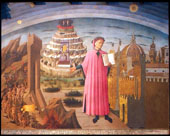
IATH Fellow Deborah Parker's World of Dante project has been added to EDSITEment's list of peer-reviewed recommended educational web sites and lesson plans. EDSITEment, a partnership between the National Endowment for the Humanities, the Verizon Foundation, and the National Trust for the Humanities, receives several hundred nominations each year. Of this list, several dozen finalists are reviewed for intellectual quality and website design and impact. EDSITEment-linked sites cover a range of humanities subjects and are judged by humanities specialists to be of high intellectual quality and useful to parents, teachers, and students.
Other IATH sites that appear on the EDSITEment list are Salem Witch Trials, Uncle Tom's Cabin and American Culture, The William Blake Archive, and The Pompeii Forum Project. The Walt Whitman Archive, which began at IATH and is now housed at the University of Nebraska, Lincoln, was also recently added.
See EDSITEment for a full list of educational web sites.
Rome Reborn debuts at SIGGRAPH - August 2008
Rome Reborn, a 3D virtual reality project centered around the city of ancient Rome, released version 2.0 at SIGGRAPH 2008 in August in Los Angeles. The project was one of several cutting-edge New Tech Demos, intended to demonstrate how research into the past invigorates the future of computer graphics and interactive techniques. It is one of the largest virtual reconstruction, cultural heritage, and digital archaeology project to date, and relies on an international collaboration designed to create an interactive 3D digital model that illustrates the urban development of ancient Rome. Bernard Frischer, director of IATH, is the project director.
Version 2.0 allowed visitors to the exhibit to explore the ancient city landscape and its numerous buildings and immerse themselves in the reconstructed 3D models of ancient Roman architecture in real-time over an internet connection.
Read more about Rome Reborn: VFXWorld News article | Siggraph 2008 Rome Reborn Demo Video
IATH Fellow Deborah Parker has been awarded the NEH Daniels Family Distinguished Teaching Professorship, 2008-2011 - April 2008
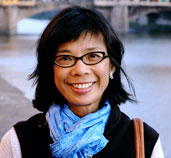
The IATH Fellow Deborah Parker has been awarded the NEH Daniels Family Distinguished Teaching Professorship, 2008-2011. This is a three-year endowed chair, given to senior humanities faculty at the University of Virginia. It recognizes and rewards excellence in teaching and encourages development of projects that share unique faculty knowledge and expertise.
During the term of the fellowship, Prof. Parker will undertake a number activities related to her IATH project, the World of Dante. She will assess the effectiveness of the teaching materials generated by the November 2007 World of Dante Workshop in conjunction with a group teachers working in different disciplines at UVA and other institutions; identify ways in which visual material enhances reading comprehension; create new materials to clarify the astronomical allusions in the Comedy; and at the end of the grant period she will organize a symposium for the group of teachers who have used the site, each of whom will give presentations on their use of The World of Dante.
The program is funded by a National Endowment for the Humanities Special Challenge Grant and is run by the University of Virginia Teaching Resource Center. Visit their site for more information on the NEH Distinguished Teaching Professorship at the University of Virginia.
American Society of Architectural Illustrators Award of Excellence Goes to Chad Keller - February 5, 2008
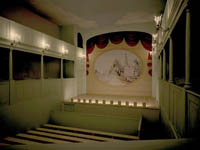
TheAmerican Society of Architectural Illustrators (www.asai.org) announced that IATH 3D Modeler Chad Keller has won the Society's Award of Excellence for his work in creating a 3D computer model illustrating the late eighteenth-century phase of the Douglass Theater in Williamsburg, Virginia. The theater was torn down by 1780 and was reconstructed digitally by a team of archaeologists, architectural historians and 3D modelers from the Colonial Williamsburg Foundation (www.history.org) and IATH. Chad was the project coordinator for IATH and was responsible for converting the ideas of the team into a 3D digital model, which was made using 3D Studio Max software. Chad's entry in this international competition was selected from over 500 works submitted by illustrators from around the world. [Click the image left: to view of the interior of Chad Keller's award-winning 3D model of the eighteenth-century Douglass Theater in Williamsburg, Virginia.] ...Read More
IATH Associate Director Invited to Join National Archive and Records Administration Advisory Committee - January 2008
[See UVa Today article April 2008]
Allen Weinstein, Archivist of the United States, has invited Daniel Pitti, Associate Director for the University of Virginia's Institute for Advanced Technology in the Humanities (IATH), to serve on the National Archives and Records Administration's (NARA) Advisory Committee on the Electronic Records Archives (ACERA). The membership of the committee is drawn from a mix of private companies, government groups, and universities
ACERA is charged with advising the Archivist of the United States on technical, mission, and service issues related to the Electronic Records Archive (ERA) system. This includes, but is not limited to, advising and making recommendations on issues related to the development, implementation, and use of the ERA system. "The digital age presents daunting challenges to the access and preservation of the records of the U.S. Government," Pitti commented. "The purpose of a national archive in democratic societies is to preserve for use the records that are legally and historically vital to transparent and accountable governance. The advent of digital communication and electronic records has created technical, social, legal, and ethical challenges to fulfilling this mandated mission."
The electronic records challenge is formidable, Weinstein says, but as an agency, NARA is committed to addressing this challenge head-on. "NARA's vision is to create a system that will authentically preserve and provide access to any kind of electronic record, free from dependency on any specific hardware or software, enabling NARA to carry out its mission into the future."
IATH was established in 1992 to revolutionize the role of technology in humanities research and humanities education. Its mission is to explore ways that information technologies and digital media can be integrated into humanities scholarship. IATH has achieved an international reputation as a leader in the field of humanities computing, and its fellows have won several prestigious awards, including the first Lincoln Award for Electronic Media; the Mellon Foundation Distinguished Achievement Award; and the Richard W. Lyman Award from the National Humanities Center. For more on IATH, visit its web site at http://jefferson.village.virginia.edu/.
2008 IATH Fellowship Opportunity Request For Proposals
December 2007
The mission of the Institute for Advanced Technology in the Humanities
(IATH) is to explore and expand the potential of information technology
as a tool for humanities research. To that end, we offer a Fellowship
Program to UVA faculty to support two distinct areas of research: (1)
the development of tools, scholarly resources, or scholarly projects
utilizing digital technology for analysis, investigation, modeling or
other research activities; and (2) the study of the nature, ethics, history,
or future of digital technology as applied to some aspect of the humanities.
Download more about the Fellowship Program here: [ Word
Doc | PDF ] Applications
for fellowships in the 2008-2009 academic year are due by March 1, 2008.
Dante Project Brings on the Music
October 2007
 "The
World of Dante," with
funding from The Gladys Krieble Delmas Foundation,
will add music to Italian professor Deborah W. Parker's Dante
research project. A selected few individuals from the musical group Zephyrus,
under the direction of Paul M. Walker, associate professor of music,
recorded approximately 20 musical pieces for the project. The recordings
for the Dante project are of chants or monophonic sacred music. Chant
encompasses all types of music, including psalms and hymns, and are distinguished
not by genre, but by musical texture, since they consist of only one
line of music. "The recordings by Zephyrus will help readers understand
the very different dynamics that prevail in the realm of the saved," said
Parker. Since most people pay little attention to the musical references
in Dante, the recordings "will allow readers to appreciate the care and
precision with which Dante makes musical references," she added.
"The
World of Dante," with
funding from The Gladys Krieble Delmas Foundation,
will add music to Italian professor Deborah W. Parker's Dante
research project. A selected few individuals from the musical group Zephyrus,
under the direction of Paul M. Walker, associate professor of music,
recorded approximately 20 musical pieces for the project. The recordings
for the Dante project are of chants or monophonic sacred music. Chant
encompasses all types of music, including psalms and hymns, and are distinguished
not by genre, but by musical texture, since they consist of only one
line of music. "The recordings by Zephyrus will help readers understand
the very different dynamics that prevail in the realm of the saved," said
Parker. Since most people pay little attention to the musical references
in Dante, the recordings "will allow readers to appreciate the care and
precision with which Dante makes musical references," she added.
[Read
Full Article] Article originally appears in UVa
Today.
IATH Announces New Fellows for 2007-2009
June 22, 2007
 IATH has announced a new Resident Fellow and three new Associate Fellows
for the 2007-2009 period. Kurtis Schaeffer, Associate Professor of Tibetan
Buddhist Studies in the Department of Religious Studies, is the new Resident
Fellow. His project, Mapping the Dalai Lamas, integrates digital texts
of classical Tibetan-language biograpies of the lives of the Dalai Lamas
with digital animated maps, timelines, and images. The project will illustrate
both the Dalai Lamas and the manner in which their biographers helped
invent the tradition of the Dalai Lamas over the centuries. His tenure
will include funding and departmental support, partial support for a
graduate research assistant, use of computer equipment and software,
and intensive technical support from the IATH staff. Read More
IATH has announced a new Resident Fellow and three new Associate Fellows
for the 2007-2009 period. Kurtis Schaeffer, Associate Professor of Tibetan
Buddhist Studies in the Department of Religious Studies, is the new Resident
Fellow. His project, Mapping the Dalai Lamas, integrates digital texts
of classical Tibetan-language biograpies of the lives of the Dalai Lamas
with digital animated maps, timelines, and images. The project will illustrate
both the Dalai Lamas and the manner in which their biographers helped
invent the tradition of the Dalai Lamas over the centuries. His tenure
will include funding and departmental support, partial support for a
graduate research assistant, use of computer equipment and software,
and intensive technical support from the IATH staff. Read More
Rome Reborn: IATH Team Rebuilds Ancient Rome Digitally
June 11, 2007
 Bernard
Frischer, director of the "Rome
Reborn" project
and director of the Institute for Advanced Technology in the Humanities
at the University of Virginia, stated, "'Rome Reborn 1.0' is the continuation
of five centuries of research by scholars, architects and artists since
the Renaissance who have attempted to restore the ruins of the ancient
city with words, maps and images. "Rome
Reborn 1.0" is a true 3D model that runs in real time. Users can navigate
through the model with complete freedom, moving up, down, left and right
at will. They can enter important public buildings such as the Roman Senate
House, the Colosseum, or the Temple of Venus and Rome, the ancient city's
largest place of worship. Read More or
go to UVa
Today | Visit "Rome
Reborn"
Bernard
Frischer, director of the "Rome
Reborn" project
and director of the Institute for Advanced Technology in the Humanities
at the University of Virginia, stated, "'Rome Reborn 1.0' is the continuation
of five centuries of research by scholars, architects and artists since
the Renaissance who have attempted to restore the ruins of the ancient
city with words, maps and images. "Rome
Reborn 1.0" is a true 3D model that runs in real time. Users can navigate
through the model with complete freedom, moving up, down, left and right
at will. They can enter important public buildings such as the Roman Senate
House, the Colosseum, or the Temple of Venus and Rome, the ancient city's
largest place of worship. Read More or
go to UVa
Today | Visit "Rome
Reborn"
Image caption: Long shot of the new digital model of Rome in which many
of the city's 7,000 buildings can be seen. In the foreground is the spur
of the Claudian aqueduct bringing water to the imperial palace on the
Palatine Hill. Just behind the aqueduct, in the middle, is the Temple
of the Divine Claudius on the Caelian Hill. In the middle ground, center,
is the Flavian Amphitheater (also known as the Colosseum). To the right is
the Ludus Magnus, a training facility for the gladiators who fought in the
nearby amphitheater, to which it was linked by a (still extant) tunnel. To
the left is the Temple of Venus and Rome, the largest temple of the state
cult in the city. Next to it is seen the Basilica of Maxentius, the last
civic building constructed in the ancient city. Behind the Flavian Amphitheater
is the Bath of Trajan on the Oppian Hill.
Copyright of The Regents of the University of California 2007.
Click image to see full view.
IATH Awarded NEH Challenge Grant
May 25, 2007
IATH Director Bernard Frischer is pleased to announce that the Institute's
application to the National Endowment for the Humanities for a challenge grant
has been approved. The grant, which totals $3.0 million, will enable IATH
to create an endowment fund in support of its cyberinfrastructure. The term
"cyberinfrastructure" refers
to research environments in which high-performance computing tools are made
available to researchers in a shared network environment. The term is recent,
but the need for institutional-level commitment to providing and supporting
cyberinfrastructure for humanities computing scholars has become apparent
within the last few years. Frischer said, "We are delighted and honored to
have been chosen by the NEH for this challenge grant. The grant comes at an
opportune time when IATH is in the early stages of its $15 million capital
campaign. Being selected by the NEH in a rigorous, peer-reviewed process puts
the 'Good Housekeeping seal of approval' on our central campaign goal of building
IATH's human and material resources through new endowment funds."
U.Va. Archaeologist Stephen Plog Elected to National Academy of Sciences
May 4, 2007
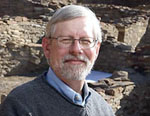 IATH Fellow, Stephen Plog, Commonwealth Professor in the University of
Virginia's department of anthropology, has been elected to the National
Academy of Sciences. Election to the academy is among the highest distinctions
for a scientist, and is based on outstanding and ongoing achievements
in original research. Read
UVa News Release | [ local version]
IATH Fellow, Stephen Plog, Commonwealth Professor in the University of
Virginia's department of anthropology, has been elected to the National
Academy of Sciences. Election to the academy is among the highest distinctions
for a scientist, and is based on outstanding and ongoing achievements
in original research. Read
UVa News Release | [ local version]
Reseller Advocate Magazine features Professor Bernard Frischer
 SFF Rises Again: Small Form Factor Just May Save the Desktop By William Van Winkle (Cover Story)
SFF Rises Again: Small Form Factor Just May Save the Desktop By William Van Winkle (Cover Story)
Read Full Article (local) | [See original article]
Prof. Frischer interviewed for German Public Radio
Google Earth instead of Trowel and Brush: Archaeologists Discover the Appeal of Computer Tools
IATH Director, Professor Bernard Frischer was interviewed for Deutschlandfunk
Radio. Listen to the interview. (Original broadcast in German, English
translation available [pdf] )
Apr.5, 2007
IATH's work on Williamsburg Playhouse presented at Theater Conference and Recognized in New York Times
March 11, 2007
 Attendees of the The Williamsburg Playhouse of 1760 and
the World of 18th-Century Theater Confernce were shown a "virtual reconstruction" of
the 1760 theater. The computer-based architectual reconstruction of the
theater is a collaborative effort teaming IATH and the Colonial Williamsburg
Foundation.
"We designed everything on computer," Mr. Graham [Colonial Williamsburg
Foundation] said, "down to the nails." Plans for an actual full-scale reconstruction
remain on the table. Want more info? Read the full article.
Attendees of the The Williamsburg Playhouse of 1760 and
the World of 18th-Century Theater Confernce were shown a "virtual reconstruction" of
the 1760 theater. The computer-based architectual reconstruction of the
theater is a collaborative effort teaming IATH and the Colonial Williamsburg
Foundation.
"We designed everything on computer," Mr. Graham [Colonial Williamsburg
Foundation] said, "down to the nails." Plans for an actual full-scale reconstruction
remain on the table. Want more info? Read the full article.
IATH to Partner with ACLS History E-Book Project
[Spring 2007]
ACLS Humanities E-Book and
The Institute for Advanced Technology in the Humanities of the University
of Virginia are happy to announce their new partnership aimed at producing,
hosting, and distributing new born-digital scholarship in the humanities.The
first fruits of their alliance, The Horace Villa Project and Beyond
Illustration. The
partnership relies on the strenghts of each organization. IATH's ground-breaking
collaborations joins with HEB's modular workflows, sustainability, and widespread
recognition. Bernard Frischer, IATH Director says "this is more than
a natural alliance between a digital production unit and a digital distributor.
IATH's
relationship with HEB is a crucial step forward in making innovative digital
scholarship sustainable and as normal a feature of the academic landscape as
print publication has long been."
New title from ACLS Humanities E-Book
[Spring 2007]
THE SCULPTED WORD: EPICUREANISM AND PHILOSOPHICAL RECRUITMENT IN ANCIENT
GREECE
Bernard
Frischer University of California Press, 1982.
Print. ACLS
Humanities E-Book, 2006. E-Book.
This XML edition uses new archaeological and visual evidence that substantially vindicates Frischer's original thesis
that the Epicureans used the visual arts as markers and visible symbols
of their philosophical approach. High-resolution image viewing and new
3D virtual reconstructions advance the possibilities for digital scholarship.
U.Va.'s Institute for Advanced Technology in the Humanities Receives IBM Research Grant
Dec. 12, 2006
The University of Virginia's Institute for Advanced Technology
in the Humanities plans to develop to enhance its visualization projects
thanks to an IBM Shared University Research award. The University of
Virginia is one of 10 academic institutions from three continents chosen
to receive the IBM grant. The SUR award allows each university to use
IBM's Cell Broadband Engine technology to connect top researchers
in academia with IBM researchers and to facilitate projects of mutual
interest.
[Read the Full Article], and listen to
Prof. Frischer's comments on IATH's accomplishment. [Audio] ![]()
The World of Dante Bookmarked:
University of Virginia Magazine
Winter Issue 2006
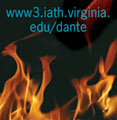
Created by Italian professor Deborah Parker while a fellow with the University's Institute for Advanced Technologies in the Humanities,
this Web site brings Dante Alighieri's "Divine Comedy" to life through hundreds of images that are accessible through tagged text
(in both Italian and English). A grant from teh National Endowment for the Humanities will allow Parker to expand the site to include Dante's "Purgatory" and "Paradise."
Virtual Williamsburg Project Launched
July 2006
On July 27, 2006, IATH and the Colonial Williamsburg Foundation began a project to capture high-resolution 3D data from the entire town of Williamsburg, Virginia.
Williamsburg served as Virginia's capital from 1699 to 1780. In the 1920s, large tracts of the areas surviving from the colonial period were purchased and restored to their original appearance.
The goals of the Virtual Williamsburg project are to create a state 3D model of the entire area of Colonial Williamsburg, including the roads and public spaces as well as the exteriors,
interiors, and furnishings of the buildings; to correct physical restorations made in the twentieth century that architectural historians of the Colonial Williamsburg Foundation consider to be erroneous;
and to create a temporal 3D model showing how the town developed from its origins to the end of the eighteenth century. The overall project is expected to last seven to ten years. In 2006-7,
thanks to a generous planning grant from the Andrew W. Mellon Foundation, the partners are engaged in planning activities and creation of a trial 3D model of the Douglass Theater near the Capitol.
NEH Awards Grant to The World of Dante
May 2006
 The
National Endowment for the Humanities (NEH) has awarded a grant of $184,060
to Deborah Parker, Professor of Italian Language and Literature, to extend
her electronic teaching resource on Dante's Divine Comedy, The
World of Dante. This multi-media
website is an educational tool intended to deepen students understanding of
Dante's remarkable visual
imagination. While many of Dante's comparisons are readily accessible, some
depend on knowledge of places or structures in Italy that few readers have
seen. The World of Dante currently includes the Italian text of the Inferno,
an English translation, illustrations and other visual material for every canto
and a scalable map of Hell. The project helps students visualize and understand
Dante's remarkable journey through the afterlife. For the past eight years,
educators and students at other institutions of higher education and at the
secondary school level have benefited from the site.
The
National Endowment for the Humanities (NEH) has awarded a grant of $184,060
to Deborah Parker, Professor of Italian Language and Literature, to extend
her electronic teaching resource on Dante's Divine Comedy, The
World of Dante. This multi-media
website is an educational tool intended to deepen students understanding of
Dante's remarkable visual
imagination. While many of Dante's comparisons are readily accessible, some
depend on knowledge of places or structures in Italy that few readers have
seen. The World of Dante currently includes the Italian text of the Inferno,
an English translation, illustrations and other visual material for every canto
and a scalable map of Hell. The project helps students visualize and understand
Dante's remarkable journey through the afterlife. For the past eight years,
educators and students at other institutions of higher education and at the
secondary school level have benefited from the site.
The grant from the NEH Division of Education will allow Professor Parker to add
the Italian text and English translation of Purgatory and Paradise, illustrations
to these canticles by Sandro Botticelli John Flaxman, Gustave Doré and other
artists, a three dimensional virtual reality map of Hell based on Botticelli's
design, a map of Dante's Italy, and photographs of sites and monuments mentioned
in the poem. NEH has also offered an additional $10,000 award if the project
can raise $10,000 in matching funds from the private sector.
SAA Awards The Walt Whitman Archive
May 2006
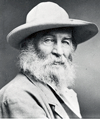 The Institute for Advanced Technology in the Humanities is pleased to announce
The Walt Whitman Archive has been selected as the recipient of the
Society of American Archivists' 2006 C.F. W. Coker Award.
The Walt Whitman Archive provides searchable, browse-able, and comprehensible guide using Encoded Archival Description for item-level description of cross-institutional manuscripts of this significant American poet.
The guide may serve as a model for future scholar-librarian-archivist collaborations developing finding aids of cross-institutional holdings.
The Institute for Advanced Technology in the Humanities is pleased to announce
The Walt Whitman Archive has been selected as the recipient of the
Society of American Archivists' 2006 C.F. W. Coker Award.
The Walt Whitman Archive provides searchable, browse-able, and comprehensible guide using Encoded Archival Description for item-level description of cross-institutional manuscripts of this significant American poet.
The guide may serve as a model for future scholar-librarian-archivist collaborations developing finding aids of cross-institutional holdings.
The Coker Award recognizes finding aids, finding aid systems, projects that involve innovative development in archival description, or descriptive tools that enable archivists to produce more effective finding aids.
To merit consideration for the award, nominees must in some significant way, set national standards, represent a model for archival description, or otherwise have a substantial impact on national descriptive practice.
IATH Sponsored Lectures
The Institute for Advanced Technology in the Humanities sponsored a few lectures on various innovations and practices in digital humanities. The subjects range from digital panoramic photography to developing tools for humanist scholars. Check out the full list of IATH Lectures.
Best Practices to Digital Panoramic Photography: QTVR and related technologies
May 12-13, 2006
 IATH,
with support from ARTstor and the Society of Architectural Historians,
held a workshop for developing a Best Practices guide for using digital
panorama photography in documenting cultural heritage sites.The workshop
was the organizing event for writing a comprehensive guide for scholars,
photographers, and students who want to use QuickTime Virtual Reality (QTVR)
and other panorama technologies.
[More on this talk]
IATH,
with support from ARTstor and the Society of Architectural Historians,
held a workshop for developing a Best Practices guide for using digital
panorama photography in documenting cultural heritage sites.The workshop
was the organizing event for writing a comprehensive guide for scholars,
photographers, and students who want to use QuickTime Virtual Reality (QTVR)
and other panorama technologies.
[More on this talk]
Spherical Photography and Cultural Heritage Sites
April 28, 2006
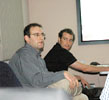 Visiting Fellows Michael and Barry Gross presented their work using QuickTime
VR (QTVR) to to document architecturally and historically important sites
in Europe and the US. Michael is the Technical Director of the Williams
College Virtual Architecture Project. They are currently collaborating
with IATH and UCLA on various projects, including the digital documentation
of the Roman Forum in Rome, Italy and the St. Gallen plan and models
in St. Gallen and Zurich, Switzerland. [Read more about it]
Visiting Fellows Michael and Barry Gross presented their work using QuickTime
VR (QTVR) to to document architecturally and historically important sites
in Europe and the US. Michael is the Technical Director of the Williams
College Virtual Architecture Project. They are currently collaborating
with IATH and UCLA on various projects, including the digital documentation
of the Roman Forum in Rome, Italy and the St. Gallen plan and models
in St. Gallen and Zurich, Switzerland. [Read more about it]
Elizabeth Jerem: Archaelogical Parks in Hungary
April 25, 2006
 Prof.
Elizabeth Jerem, Senior Research Fellow, Archaeological Institute of
the Hungarian Academy of Sciences, Budapest, Hungary Associate Professor,
Department of Ancient History and Archaeology, Faculty of Arts, University
of Miskolc, Hungary Executive Direktor of Archaeolingua Foundation, Editor
of the Publication Series ARCHAEOLINGUA. Professor's Jerem
presentation provided an overview on the history
of Hungarian archaeological presentation sites and parks, by going
through the various open-air museums in terms of their chronology and
function. [More on Professor Jerem's talk]
Prof.
Elizabeth Jerem, Senior Research Fellow, Archaeological Institute of
the Hungarian Academy of Sciences, Budapest, Hungary Associate Professor,
Department of Ancient History and Archaeology, Faculty of Arts, University
of Miskolc, Hungary Executive Direktor of Archaeolingua Foundation, Editor
of the Publication Series ARCHAEOLINGUA. Professor's Jerem
presentation provided an overview on the history
of Hungarian archaeological presentation sites and parks, by going
through the various open-air museums in terms of their chronology and
function. [More on Professor Jerem's talk]
Ian Johnson: Building a Collaborative Knowledge Space for Humanist Scholars
April 11, 2006
 Ian
Johnson, Director Archaeological Computing Laboratory & TimeMap Project
Senior Research Fellow, Archaeology University of Sydney, visited IATH
to present,
Building a Collaborative Knowledge Space for Humanist
Scholars. His talk
covered two tools for Humanist scholars - Heurist and T1000 - which we
have been developing as part of a Collaborative KnowledgeSpace (CKS)
project for the Sydney Humanities and Social Sciences e-Research Initiative
(SHSSERI). [More information] on this
interesting talk.
Ian
Johnson, Director Archaeological Computing Laboratory & TimeMap Project
Senior Research Fellow, Archaeology University of Sydney, visited IATH
to present,
Building a Collaborative Knowledge Space for Humanist
Scholars. His talk
covered two tools for Humanist scholars - Heurist and T1000 - which we
have been developing as part of a Collaborative KnowledgeSpace (CKS)
project for the Sydney Humanities and Social Sciences e-Research Initiative
(SHSSERI). [More information] on this
interesting talk.
Bernard Frischer Receives Pioneer Award from VSMM in Belgium
 Bernard
Frischer, Director of IATH, receives the first Pioneer Award of the International
Society of Virtual Systems and Multimedia from Neil Silberman, Director
of the Ename Center for Public Archaeology and Heritage Presentation. Ghent,
Belgium, October 6, 2005
[Full
Story]
Bernard
Frischer, Director of IATH, receives the first Pioneer Award of the International
Society of Virtual Systems and Multimedia from Neil Silberman, Director
of the Ename Center for Public Archaeology and Heritage Presentation. Ghent,
Belgium, October 6, 2005
[Full
Story]
Live of Saints: Modern tools bring medieval literature to researchers
October 2005
 The Lives of Saints: The Medieval French Hagiography Project is
featured in Oscar... "Amy
Ogden is on a quest, searching for stories from the middle ages, sagas
written in old French on parchment - some
illuminated with gold, gorgeous manuscripts that would cost a herd of
sheep to produce, others more utilitarian, rough volumes copied by individuals
who were nearly illiterate but deeply devoted to God. Ogden is looking
for Lives of saints."
Read the whole story Photo
by Jack Mellott.
The Lives of Saints: The Medieval French Hagiography Project is
featured in Oscar... "Amy
Ogden is on a quest, searching for stories from the middle ages, sagas
written in old French on parchment - some
illuminated with gold, gorgeous manuscripts that would cost a herd of
sheep to produce, others more utilitarian, rough volumes copied by individuals
who were nearly illiterate but deeply devoted to God. Ogden is looking
for Lives of saints."
Read the whole story Photo
by Jack Mellott.
NEH awards Aquae Urbis Romae
National Endowment for the Humanities has awarded both Prof. Bernie Frischer
and Katherine Rinne a Collaborative Research Grant for the Aquae
Urbis Romae: The Waters of the City of Rome project. The grant
will allow the project to begin adding GIS data and expanding a freely
accessible and fully interactive inventory of Roman hydraulic infrastructure
from the early modern period.
Aquae Urbis Romae: The Waters of the City of Rome addresses issues related
to the history of Roman water infrastructure and urban development over a 2,700-year
period. It is a truly interdisciplinary interactive, web-based cartographic
archive of original research and historic materials that brings together data
from archaeology, urban history, geography, classics, and the history of technology
in order to address specific questions about Rome's urban development
and more wide-ranging issues about water and urban development. The project
systematically incorporates archeological, archival, literary, and epigraphic
evidence in original chronological and thematic topographic maps of Rome.
Arapesh Grammar and Digital Language Archive
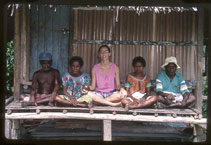 Thanks
to a generous grant from the National Endowment for the Humanities,
IATH resources will now be applied to a new area of humanistic concern:
documenting and preserving the world's endangered languages. IATH
technical staff will support the Arapesh Grammar and Digital Language
Archive project directed by Lise Dobrin of UVA's Department
of Anthropology, along with UVA digital media expert English Professor
David Golumbia and IATH text encoding specialist Daniel Pitti. The project
will create a rich digital repository of sound recordings, text, and
grammatical information about the endangered Arapesh family of languages,
which are known to linguistic science for their unusual sound-based
noun classification and agreement systems. Traditionally spoken by people
living along the New Guinea north coast, in many villages Arapesh is
no longer being learned by children, who grow up speaking the local
lingua franca Tok Pisin instead. In addition to ensuring that Arapesh
is preserved in a robust form for future generations, the Digital
Language Archive will serve as a research tool for the other part
of Dobrin's project, producing a written grammar of Arapesh focusing
on the Cemaun dialect. A multilingual, multimedia web site will also
be developed to provide the public with an accessible resource on this
remarkable group of languages.
Thanks
to a generous grant from the National Endowment for the Humanities,
IATH resources will now be applied to a new area of humanistic concern:
documenting and preserving the world's endangered languages. IATH
technical staff will support the Arapesh Grammar and Digital Language
Archive project directed by Lise Dobrin of UVA's Department
of Anthropology, along with UVA digital media expert English Professor
David Golumbia and IATH text encoding specialist Daniel Pitti. The project
will create a rich digital repository of sound recordings, text, and
grammatical information about the endangered Arapesh family of languages,
which are known to linguistic science for their unusual sound-based
noun classification and agreement systems. Traditionally spoken by people
living along the New Guinea north coast, in many villages Arapesh is
no longer being learned by children, who grow up speaking the local
lingua franca Tok Pisin instead. In addition to ensuring that Arapesh
is preserved in a robust form for future generations, the Digital
Language Archive will serve as a research tool for the other part
of Dobrin's project, producing a written grammar of Arapesh focusing
on the Cemaun dialect. A multilingual, multimedia web site will also
be developed to provide the public with an accessible resource on this
remarkable group of languages.
![]() Click image for closer view and to hear sound recording.
Click image for closer view and to hear sound recording.
[Image: Some of the Cemaun Arapesh people Dobrin worked with in Wautogik village
(East Sepik Province, Papua New Guinea): Abahinem clan leader Clemen Hayin
and his wife Lusia (left), and Arnold Watiem and his wife Margaret (right)]
Whitman Archive in the News
The Walt Whitman Archive is celebrating the 150 year anniversary of
the publication of "Leaves
of Grass" by sharing 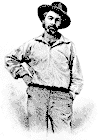 the
exciting works of the archive with the world. The May 30 issue of Newsweek,
in "Time
to Celebrate," recommends the Walt Whitman Archive to its readers
(p.78). See the Newsweek article online.
The celebration continued on July 4th, interviews
with Archive editors Ed Folsom and Kenneth M. Price were featured in two
separate NPR programs, Talk of the Nation and Day to Day. Both are available
online.
The first story is entitled "Celebrating Walt Whitman and 'Leaves of
Grass'" and the second is 'Leaves of Grass' Published 150 Years
Ago."
the
exciting works of the archive with the world. The May 30 issue of Newsweek,
in "Time
to Celebrate," recommends the Walt Whitman Archive to its readers
(p.78). See the Newsweek article online.
The celebration continued on July 4th, interviews
with Archive editors Ed Folsom and Kenneth M. Price were featured in two
separate NPR programs, Talk of the Nation and Day to Day. Both are available
online.
The first story is entitled "Celebrating Walt Whitman and 'Leaves of
Grass'" and the second is 'Leaves of Grass' Published 150 Years
Ago."
In the July/August (vol.
26, no. 4) issue of Humanities: The Magazine of the National Endowment
for the Humanities includes"Whitman's
Lifelong Endeavor: Leaves of Grass at 150," a feature story
by Geoffrey Saunders Schramm on the Archive's poetry-editing project.
The Archive's integrated EAD finding aid project is the subject of "Whitman
Speaks to a New Generation," an article written for the IMLS web
site, available at http://www.imls.gov/closer/hlt_c0705.htm
Blake Archive Approved by MLA
The William
Blake Archive has been designated an Approved Edition by
the Modern Language Association.  This is the first time the organization has awarded its "seal" to
an electronic edition. The MLA's
Committee on Scholarly Editions has been fostering rigorous editorial
standards for printed editions since 1976. David V. Erdman's Complete
Poetry and Prose of William Blake received
the MLA seal in 1981. The Committee's guidelines for electronic
editions were first published in 2004 as part of a major revision of
the Committee's
editorial guidelines (http://www.mla.org/cse_guidelines;
see also Burnard, O'Keefe, and Unsworth, Electronic
Textual Editing,
MLA/TEI, forthcoming 2006). Previously, the Archive was the 2002-2003
recipient of the MLA's Prize for a Distinguished Scholarly Edition.
This is the first time the organization has awarded its "seal" to
an electronic edition. The MLA's
Committee on Scholarly Editions has been fostering rigorous editorial
standards for printed editions since 1976. David V. Erdman's Complete
Poetry and Prose of William Blake received
the MLA seal in 1981. The Committee's guidelines for electronic
editions were first published in 2004 as part of a major revision of
the Committee's
editorial guidelines (http://www.mla.org/cse_guidelines;
see also Burnard, O'Keefe, and Unsworth, Electronic
Textual Editing,
MLA/TEI, forthcoming 2006). Previously, the Archive was the 2002-2003
recipient of the MLA's Prize for a Distinguished Scholarly Edition.
The Digital St. Gall Monastic Plan Project
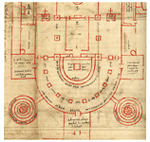 The
Andrew W. Mellon Foundation has given IATH and its partner, the UCLA
Center for Medieval and Renaissance Studies, a three-year grant of over
$1 million to create an online resource for the study of the famous Monastic
Building Plan of St. Gall. The plan, drawn on five pieces of vellum stitched
together, dates to the 820s AD and is the oldest architectural plan surviving
in Europe. The monastery laid out in the manuscript contained over
50 individual buildings and features as well as 342 explanatory
inscriptions, partly in prose and partly in verse. The purpose of
the project is to make the Plan and scholarship about it more accessible
to students and scholars. Principal investigator is UCLA History
Professor Patrick Geary; co-principal investigator is IATH Director
Bernard Frischer. The project will be advised by a distinguished
international team of scholars from the University of Vienna, the
Courtauld Institute in London, the University of Southern California,
and the Monastic Library of St. Gall in Switzerland.
The
Andrew W. Mellon Foundation has given IATH and its partner, the UCLA
Center for Medieval and Renaissance Studies, a three-year grant of over
$1 million to create an online resource for the study of the famous Monastic
Building Plan of St. Gall. The plan, drawn on five pieces of vellum stitched
together, dates to the 820s AD and is the oldest architectural plan surviving
in Europe. The monastery laid out in the manuscript contained over
50 individual buildings and features as well as 342 explanatory
inscriptions, partly in prose and partly in verse. The purpose of
the project is to make the Plan and scholarship about it more accessible
to students and scholars. Principal investigator is UCLA History
Professor Patrick Geary; co-principal investigator is IATH Director
Bernard Frischer. The project will be advised by a distinguished
international team of scholars from the University of Vienna, the
Courtauld Institute in London, the University of Southern California,
and the Monastic Library of St. Gall in Switzerland.
Click image
for larger view. [Image: Atrium,
Tower and Western Part of Church] The Plan of St. Gall. University
of California Press, Berkeley, 1979]
International Workshop on Leonardo da Vinci and His Treatise on Painting
September 2005
 IATH
and the Carl H. and Martha S. Lindner Center for Art History are conducting
an International
Workshop October 10 and 11th for leading experts on Leonardo Da Vinci
to review plans for development of an electronic archive of Leonardo's
Treatise on Painting. Directed by Art History Professor Francesca Fiorani,
the project will be the first, systematic study of the many manuscripts
of the Treatise, which was crucial for disseminating Leonardo's theory
of art. The goal of the workshop is to present the project to a select
group of major scholars for their review and evaluation, and to encourage
their active collaboration and support of the project. The resulting
report will be used to refine plans and solicit funds for the complete
development of the virtual archive.
IATH
and the Carl H. and Martha S. Lindner Center for Art History are conducting
an International
Workshop October 10 and 11th for leading experts on Leonardo Da Vinci
to review plans for development of an electronic archive of Leonardo's
Treatise on Painting. Directed by Art History Professor Francesca Fiorani,
the project will be the first, systematic study of the many manuscripts
of the Treatise, which was crucial for disseminating Leonardo's theory
of art. The goal of the workshop is to present the project to a select
group of major scholars for their review and evaluation, and to encourage
their active collaboration and support of the project. The resulting
report will be used to refine plans and solicit funds for the complete
development of the virtual archive.
This workshop will also enable the Leonardo Project to define the terms of
a working relationship with the famous Elmer Belt Library of Vinciana at UCLA.
The Belt Library is one of the world's leading repositories of materials
useful for the study of the works associated with Leonardo, including the Treatise
on Painting.
The first day of the workshop will feature presentations from the Leonardo
scholars, and the general university community is invited to attend. It will
be held at the Harrison Institute, Byrd Seminar Room 318.
Summit on Digital Tools for the Humanities
September 28-30, 2005
University of Virginia
Summit Objective: Digital tools and the underlying cyber
infrastructure expand the opportunities for humanistic scholarship and
education. They enable new and innovative approaches to humanistic scholarship.
They provide scholars and students deeper and more sophisticated access
to cultural materials, thus changing how material can be taught and experienced.
They facilitate new forms of collaboration of all those who touch the
digital representation of the human record.
For more information See "Summit
on Digital Tools for the Humanities". Or
download summit announcement [Word Doc] | [PDF]

Bernie Frischer featured in The Chronicle
Soaring Through Ancient Rome, Virtually: A compact version of existing technology
lets archaeologists and art historians revisit the past The
Chronicle of Higher Education, July 2005
Virginia Digital Collaboratorium
February 2005
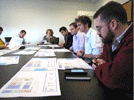 In February, 2005 the Institute
for Advanced Technology in the Humanities (IATH) announced
creation of the Virginia Digital Collaboratorium, which will open its
doors in late 2005. The Collaboratorium will be located in the Emerging
Technology Building at the University's North Fork Research Park in
over 2,700 square feet of new office space. "The Collaboratorium
will not only be an attractive space in which to work, it will also
be an attractor of new industry to the Charlottesville area and a vehicle
for strengthening ties between the University and the IT community
already based in central Virginia," stated IATH Director Bernard
Frischer. Anselmo
Canfora, Assistant Professor of Architecture, will assist in efforts
to design the furniture and layouts for the work areas in the Virginia
Digital Collaboratorium.
In February, 2005 the Institute
for Advanced Technology in the Humanities (IATH) announced
creation of the Virginia Digital Collaboratorium, which will open its
doors in late 2005. The Collaboratorium will be located in the Emerging
Technology Building at the University's North Fork Research Park in
over 2,700 square feet of new office space. "The Collaboratorium
will not only be an attractive space in which to work, it will also
be an attractor of new industry to the Charlottesville area and a vehicle
for strengthening ties between the University and the IT community
already based in central Virginia," stated IATH Director Bernard
Frischer. Anselmo
Canfora, Assistant Professor of Architecture, will assist in efforts
to design the furniture and layouts for the work areas in the Virginia
Digital Collaboratorium.
Digital Tibet Joining cultures and scholars online
Arts & Sciences Online January 2004
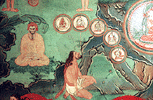 Charlottesville
and Tibet are more than 7,500 miles apart. Politically and socially,
the figurative distance is even greater. Yet Charlottesville is home
to a world-renowned center of learning about Tibetan language, religion,
history and culture: the University's Tibetan Studies program.
The program is among the oldest and biggest of its kind in the nation.
It is arguably the most technologically advanced, with a remarkable online
project-the Tibetan
and Himalayan Digital Library (THDL) that is knitting
together the diverse international community of Tibetan scholars and
fast becoming a voluminous repository for Tibet-related knowledge. "From
an outside perspective, it's a very well-balanced program," said
Jose I. Cabezon, the 14th Dalai Lama Professor of Tibetan Buddhism and
Cultural Studies at the University of California at Santa Barbara. [Full
Article]
Charlottesville
and Tibet are more than 7,500 miles apart. Politically and socially,
the figurative distance is even greater. Yet Charlottesville is home
to a world-renowned center of learning about Tibetan language, religion,
history and culture: the University's Tibetan Studies program.
The program is among the oldest and biggest of its kind in the nation.
It is arguably the most technologically advanced, with a remarkable online
project-the Tibetan
and Himalayan Digital Library (THDL) that is knitting
together the diverse international community of Tibetan scholars and
fast becoming a voluminous repository for Tibet-related knowledge. "From
an outside perspective, it's a very well-balanced program," said
Jose I. Cabezon, the 14th Dalai Lama Professor of Tibetan Buddhism and
Cultural Studies at the University of California at Santa Barbara. [Full
Article]
U.Va Online Project examines History of Gender Roles in China
UVA Top News Daily January 2004
 Jiang,
the wife of the king, was alone on the terrace when the river began to
rise. The king sent one of his men to take her to a safer place, but the
aide forgot to bring his official seal signifying the king's approval.
So Jiang chose to stay and drown rather than break palace rules and leave
dishonorably. Such models of chaste and obedient behavior by women, a
key element in Chinese cultural history, are portrayed in a famous textbook
for female education in early China - "Traditions
of Exemplary Women" (Leinü zhuan)
by Liu Xiang - that influenced the status of women there for some 2,000
years. Soon, scholars and students interested in China and comparative
women's
studies will be able to explore more closely the forces that shaped gender
roles, politics and culture there as part of a University of Virginia
project, "Traditions
of Exemplary Women: A Digital Research Collection," that focuses on the
book's neglected history. Directed by Anne Behnke Kinney, professor of Chinese
and director of U.Va.'s
East Asia Center, the bilingual project now under development is the
first large-scale study of women in early China and the first of such
size to employ state-of-the-art information technology to study Chinese
history. The Web project will present electronic versions of rare Chinese
texts and an authoritative new translation by Kinney of "Traditions," as
well as important early sources, extensive annotations, essays, maps
and images. [Full
Article]
Jiang,
the wife of the king, was alone on the terrace when the river began to
rise. The king sent one of his men to take her to a safer place, but the
aide forgot to bring his official seal signifying the king's approval.
So Jiang chose to stay and drown rather than break palace rules and leave
dishonorably. Such models of chaste and obedient behavior by women, a
key element in Chinese cultural history, are portrayed in a famous textbook
for female education in early China - "Traditions
of Exemplary Women" (Leinü zhuan)
by Liu Xiang - that influenced the status of women there for some 2,000
years. Soon, scholars and students interested in China and comparative
women's
studies will be able to explore more closely the forces that shaped gender
roles, politics and culture there as part of a University of Virginia
project, "Traditions
of Exemplary Women: A Digital Research Collection," that focuses on the
book's neglected history. Directed by Anne Behnke Kinney, professor of Chinese
and director of U.Va.'s
East Asia Center, the bilingual project now under development is the
first large-scale study of women in early China and the first of such
size to employ state-of-the-art information technology to study Chinese
history. The Web project will present electronic versions of rare Chinese
texts and an authoritative new translation by Kinney of "Traditions," as
well as important early sources, extensive annotations, essays, maps
and images. [Full
Article]
The Circus comes to Charlottesville
Explorations: Research & Public Service, Spring 2004
![]() LaVahn Hoh's first encounter with the circus was momentous. "It made such an
impression on me that I can still describe what I saw that day," he recalls.
Fifty years later, Hoh is as passionate about the circus as ever-but
now he knows more about it than all but a handful of people. Hoh, a professor
of drama and an expert in technical theater and special effects, could never
get the sawdust out of his veins. As an adult, he continued to go to circuses
every chance he could, visiting such shrines for circus lovers as the Circus
World Museum in Baraboo, Wisconsin, and the Ringling Museum of the Circus in
Sarasota, Florida. [Full Article]
LaVahn Hoh's first encounter with the circus was momentous. "It made such an
impression on me that I can still describe what I saw that day," he recalls.
Fifty years later, Hoh is as passionate about the circus as ever-but
now he knows more about it than all but a handful of people. Hoh, a professor
of drama and an expert in technical theater and special effects, could never
get the sawdust out of his veins. As an adult, he continued to go to circuses
every chance he could, visiting such shrines for circus lovers as the Circus
World Museum in Baraboo, Wisconsin, and the Ringling Museum of the Circus in
Sarasota, Florida. [Full Article]
Ben Ray's Salem Mass., hysteria
Oscar September 2004
 On September 18, 1692, Giles Cory was "pressed to death" after being accused
of witchcraft. While all the other men and women who died in the Salem Witch
Trials were hanged, Cory refused a trial by jury and thus got the dreaded sentence
of peine forte et dure, which calls for rocks to be piled on top of the accused
until he expires under the load. In Cory's case, it took two days. He was obstinate
to the end; his last words were, "More weight!" [Full
Article]
On September 18, 1692, Giles Cory was "pressed to death" after being accused
of witchcraft. While all the other men and women who died in the Salem Witch
Trials were hanged, Cory refused a trial by jury and thus got the dreaded sentence
of peine forte et dure, which calls for rocks to be piled on top of the accused
until he expires under the load. In Cory's case, it took two days. He was obstinate
to the end; his last words were, "More weight!" [Full
Article]
IATH Selects New Fellows for 2004
 The University's Institute for Advanced Technology in the Humanities
(IATH) has awarded its 2004-2006 Fellowship to Francesca Fiorani, Assistant
Professor of Art History, based on the strength of her proposed project, "Leonardo
Da Vinci and his Treatise on Painting." With the resources provided
through the IATH Fellowship, including IATH staff, space and computers,
Professor Fiorani will create a thematic collection of digital materials
derived from the various editions of Leonardo's Treatise. From the mid-sixteenth
to the late eighteenth centuries these editions were the primary source
for Leonardo's artistic theories. The resulting thematic collection will
provide a foundation for comparative studies among these editions. One
of the technical challenges of the project will be to design the information
structures to allow access to the complex interrelationships between
text, image and artistic process that are required by Leonardo's exposition
of his theories.
The University's Institute for Advanced Technology in the Humanities
(IATH) has awarded its 2004-2006 Fellowship to Francesca Fiorani, Assistant
Professor of Art History, based on the strength of her proposed project, "Leonardo
Da Vinci and his Treatise on Painting." With the resources provided
through the IATH Fellowship, including IATH staff, space and computers,
Professor Fiorani will create a thematic collection of digital materials
derived from the various editions of Leonardo's Treatise. From the mid-sixteenth
to the late eighteenth centuries these editions were the primary source
for Leonardo's artistic theories. The resulting thematic collection will
provide a foundation for comparative studies among these editions. One
of the technical challenges of the project will be to design the information
structures to allow access to the complex interrelationships between
text, image and artistic process that are required by Leonardo's exposition
of his theories.
 IATH
has awarded, an Associate Fellowship to Amy Ogden, Assistant Professor
of French, for her proposed "Lives
of the Saints: The Medieval French Hagiography Project." Professor Ogden's project will build an electronic collection
of textual and material information about saints' narratives in Old
French and the manuscripts that preserve them. IATH staff will consult
with Professor Ogden on how to present the multi-dimensionality of
these texts in ways that will invite scholars to rethink not only the
nature and importance of this key medieval genre, but also, more generally,
issues of medieval textuality.
IATH
has awarded, an Associate Fellowship to Amy Ogden, Assistant Professor
of French, for her proposed "Lives
of the Saints: The Medieval French Hagiography Project." Professor Ogden's project will build an electronic collection
of textual and material information about saints' narratives in Old
French and the manuscripts that preserve them. IATH staff will consult
with Professor Ogden on how to present the multi-dimensionality of
these texts in ways that will invite scholars to rethink not only the
nature and importance of this key medieval genre, but also, more generally,
issues of medieval textuality.
Bernard Frischer is the new Director of The Institute for Advanced Technology in the Humanities
 The Vice President and Provost has appointed Bernard Frischer as the new
Director of UVA's Institute for Advanced Technology in the Humanities,
beginning in the Fall term 2004. He will also join the faculty as Professor
of Classics and Art History. "It is an honor and challenge to be chosen
to succeed John Unsworth, the first Director of IATH," says Frischer. "Under
John's leadership, IATH established itself as the premier research center
in the United States for digital humanities. It is my hope to build on
the achievements of the past by helping to make digital humanities a sustainable
and integral approach to humanistic research both at Virginia and at other
major universities around the world.
The Vice President and Provost has appointed Bernard Frischer as the new
Director of UVA's Institute for Advanced Technology in the Humanities,
beginning in the Fall term 2004. He will also join the faculty as Professor
of Classics and Art History. "It is an honor and challenge to be chosen
to succeed John Unsworth, the first Director of IATH," says Frischer. "Under
John's leadership, IATH established itself as the premier research center
in the United States for digital humanities. It is my hope to build on
the achievements of the past by helping to make digital humanities a sustainable
and integral approach to humanistic research both at Virginia and at other
major universities around the world.
IATH's Daniel Pitti Named A Fellow of the Society of American Archivists
 Daniel Pitti, of the Institute for Advanced Technology in the Humanities
at the University of Virginia, Charlottesville, was named a Fellow of
the Society of American Archivists on Aug. 6, 2004, during SAA's 68 th
Annual Meeting in Boston. Established in 1957 and conferred annually,
the distinction of Fellow is the highest honor bestowed on individuals
by SAA and is awarded for outstanding contributions to the archival profession.
Pitti joins 148 current members honored as Fellows out of a membership
of more than 3,900. [Full Article]
Daniel Pitti, of the Institute for Advanced Technology in the Humanities
at the University of Virginia, Charlottesville, was named a Fellow of
the Society of American Archivists on Aug. 6, 2004, during SAA's 68 th
Annual Meeting in Boston. Established in 1957 and conferred annually,
the distinction of Fellow is the highest honor bestowed on individuals
by SAA and is awarded for outstanding contributions to the archival profession.
Pitti joins 148 current members honored as Fellows out of a membership
of more than 3,900. [Full Article]
MLA Awards Prize to William Blake Archive
November 2003
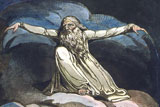 The
Modern Language Association of America has announced the winner
of the fifth Modern Language Association Prize for a Distinguished
Scholarly Edition. The prize will be presented to Morris Eaves (Univ.
of Rochester), Robert N. Essick (Univ. of California, Riverside), and
Joseph Viscomi (Univ. of North Carolina), for their Web site the William
Blake Archive, administered by the Institute for Advanced Technology
in the Humanities. The coeditors will receive a total of $1,000 plus
certificates containing the text of the selection committee s citation.
Honorable mention goes to Margaret Jane Kidnie (Univ. of Western Ontario)
for her edition of Philip Stubbes, The Anatomie of Abuses, published
by the Arizona Center for Medieval and Renaissance Studies. Kidnie
will receive a certificate containing the text of the selection committee's
citation. [Full Article]
The
Modern Language Association of America has announced the winner
of the fifth Modern Language Association Prize for a Distinguished
Scholarly Edition. The prize will be presented to Morris Eaves (Univ.
of Rochester), Robert N. Essick (Univ. of California, Riverside), and
Joseph Viscomi (Univ. of North Carolina), for their Web site the William
Blake Archive, administered by the Institute for Advanced Technology
in the Humanities. The coeditors will receive a total of $1,000 plus
certificates containing the text of the selection committee s citation.
Honorable mention goes to Margaret Jane Kidnie (Univ. of Western Ontario)
for her edition of Philip Stubbes, The Anatomie of Abuses, published
by the Arizona Center for Medieval and Renaissance Studies. Kidnie
will receive a certificate containing the text of the selection committee's
citation. [Full Article]
